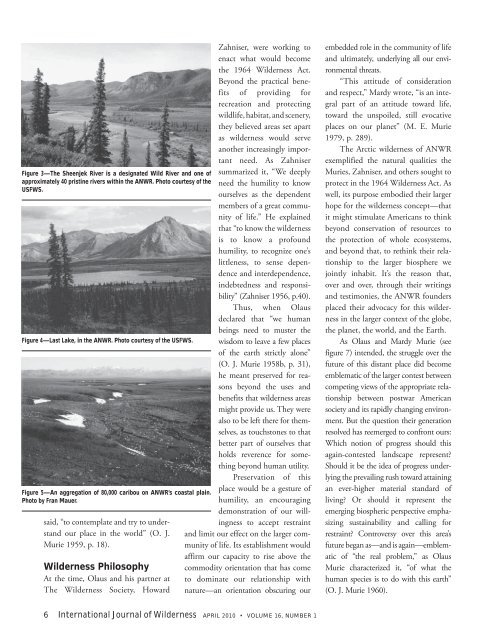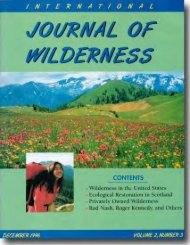Ten Tribes Reclaiming, Stewarding, and Restoring Ancestral Lands
Ten Tribes Reclaiming, Stewarding, and Restoring Ancestral Lands
Ten Tribes Reclaiming, Stewarding, and Restoring Ancestral Lands
Create successful ePaper yourself
Turn your PDF publications into a flip-book with our unique Google optimized e-Paper software.
Figure 3—The Sheenjek River is a designated Wild River <strong>and</strong> one of<br />
approximately 40 pristine rivers within the ANWR. Photo courtesy of the<br />
USFWS.<br />
Figure 4—Last Lake, in the ANWR. Photo courtesy of the USFWS.<br />
Figure 5—An aggregation of 80,000 caribou on ANWR’s coastal plain.<br />
Photo by Fran Mauer.<br />
said, “to contemplate <strong>and</strong> try to underst<strong>and</strong><br />
our place in the world” (O. J.<br />
Murie 1959, p. 18).<br />
Wilderness Philosophy<br />
At the time, Olaus <strong>and</strong> his partner at<br />
The Wilderness Society, Howard<br />
Zahniser, were working to<br />
enact what would become<br />
the 1964 Wilderness Act.<br />
Beyond the practical benefits<br />
of providing for<br />
recreation <strong>and</strong> protecting<br />
wildlife, habitat, <strong>and</strong> scenery,<br />
they believed areas set apart<br />
as wilderness would serve<br />
another increasingly important<br />
need. As Zahniser<br />
summarized it, “We deeply<br />
need the humility to know<br />
ourselves as the dependent<br />
members of a great community<br />
of life.” He explained<br />
that “to know the wilderness<br />
is to know a profound<br />
humility, to recognize one’s<br />
littleness, to sense dependence<br />
<strong>and</strong> interdependence,<br />
indebtedness <strong>and</strong> responsibility”<br />
(Zahniser 1956, p.40).<br />
Thus, when Olaus<br />
declared that “we human<br />
beings need to muster the<br />
wisdom to leave a few places<br />
of the earth strictly alone”<br />
(O. J. Murie 1958b, p. 31),<br />
he meant preserved for reasons<br />
beyond the uses <strong>and</strong><br />
benefits that wilderness areas<br />
might provide us. They were<br />
also to be left there for themselves,<br />
as touchstones to that<br />
better part of ourselves that<br />
holds reverence for something<br />
beyond human utility.<br />
Preservation of this<br />
place would be a gesture of<br />
humility, an encouraging<br />
demonstration of our willingness<br />
to accept restraint<br />
<strong>and</strong> limit our effect on the larger community<br />
of life. Its establishment would<br />
affirm our capacity to rise above the<br />
commodity orientation that has come<br />
to dominate our relationship with<br />
nature—an orientation obscuring our<br />
6 International Journal of Wilderness APRIL 2010 VOLUME 16, NUMBER 1<br />
embedded role in the community of life<br />
<strong>and</strong> ultimately, underlying all our environmental<br />
threats.<br />
“This attitude of consideration<br />
<strong>and</strong> respect,” Mardy wrote, “is an integral<br />
part of an attitude toward life,<br />
toward the unspoiled, still evocative<br />
places on our planet” (M. E. Murie<br />
1979, p. 289).<br />
The Arctic wilderness of ANWR<br />
exemplified the natural qualities the<br />
Muries, Zahniser, <strong>and</strong> others sought to<br />
protect in the 1964 Wilderness Act. As<br />
well, its purpose embodied their larger<br />
hope for the wilderness concept—that<br />
it might stimulate Americans to think<br />
beyond conservation of resources to<br />
the protection of whole ecosystems,<br />
<strong>and</strong> beyond that, to rethink their relationship<br />
to the larger biosphere we<br />
jointly inhabit. It’s the reason that,<br />
over <strong>and</strong> over, through their writings<br />
<strong>and</strong> testimonies, the ANWR founders<br />
placed their advocacy for this wilderness<br />
in the larger context of the globe,<br />
the planet, the world, <strong>and</strong> the Earth.<br />
As Olaus <strong>and</strong> Mardy Murie (see<br />
figure 7) intended, the struggle over the<br />
future of this distant place did become<br />
emblematic of the larger contest between<br />
competing views of the appropriate relationship<br />
between postwar American<br />
society <strong>and</strong> its rapidly changing environment.<br />
But the question their generation<br />
resolved has reemerged to confront ours:<br />
Which notion of progress should this<br />
again-contested l<strong>and</strong>scape represent?<br />
Should it be the idea of progress underlying<br />
the prevailing rush toward attaining<br />
an ever-higher material st<strong>and</strong>ard of<br />
living? Or should it represent the<br />
emerging biospheric perspective emphasizing<br />
sustainability <strong>and</strong> calling for<br />
restraint? Controversy over this area’s<br />
future began as—<strong>and</strong> is again—emblematic<br />
of “the real problem,” as Olaus<br />
Murie characterized it, “of what the<br />
human species is to do with this earth”<br />
(O. J. Murie 1960).










